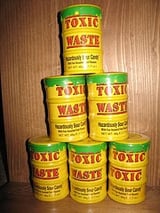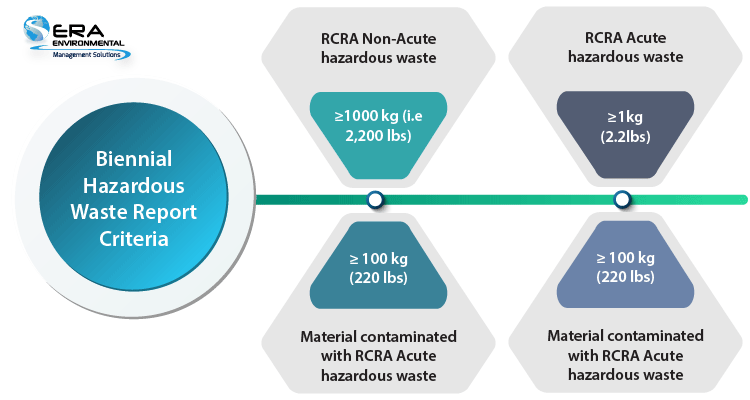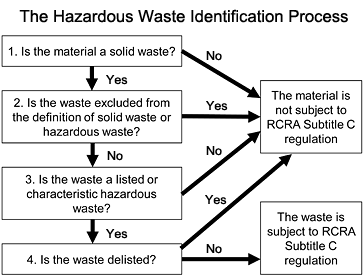
Knowing if you are one of the many facilities required to file a Biennial Hazardous Waste Report with the EPA is not necessarily a straightforward affair. The characteristics that determine if you need to submit a hazardous waste report are filled with tricky conditions, making it somewhat difficult to know exactly how to classify yourself. To help combat this hazardous waste confusion, ERA has prepared this short guide to walk you through figuring out whether you need to complete a hazardous material report.
Essentially, you need to submit a hazardous waste report if your facility is a Large Quantity Generator (abbreviated to LQG) or if you treated, stored, or disposed of hazardous waste on-site.
How Do You Know if Waste is Hazardous?
So, how do you know if waste is hazardous? First, we must define what Hazardous waste is. Hazardous waste is defined as waste that has properties that are a threat to human health or the environment. The EPA has a few questions that you should ask to determine if your waste is hazardous. The questions are presented in the diagram below and we are going to break them down further to provide guidance on how to answer them.
Is the Waste a "Solid Waste"?
Solid waste is any material that is discarded in any way including being disposed of, burned, accumulated, or stored before being abandoned, recycled, or reclaimed. Under RCRA, the term "solid waste" does not only mean waste that is solid in form, but it also means any waste, whether it is a solid, semisolid, or liquid. This waste is created from most industrial operations. The material cannot be classified as hazardous waste if it does not meet the definition of solid waste.
What is a non-RCRA Hazardous Waste?
You must consider if the waste is specifically excluded from the RCRA regulations. Materials that do not fit the definition for solid waste are excluded from RCRA reporting. There is a long list of these chemicals that include industrial wastewater that is covered under the Clean Water Act, materials only stored in tanks with close reclamation through pipes and other secondary materials that are reclaimed from reuse among many other chemicals. A comprehensive list of excluded materials can be found on the EPA website.
Is the Waste a "Listed" Hazardous Waste?
You must know if your waste is listed as hazardous waste. There are four lists of hazardous waste. The lists are List F, for non-specific source wastes, List K, for source-specific wastes, and lists P and U for discarded commercial chemical products.
List F covers waste from specific industrial processes such as spent solvent wastes, electroplating and other metal finishing wastes, dioxin-bearing wastes and more. List K covers source-specific water from certain industries such as wood preservation, organic chemicals manufacturing, petroleum refining and many more. The chemicals covered in the P and U list must be pure chemicals used in industrial processes or the main active ingredient in the formulation.
Does Waste Exhibit a Characteristic of Hazardous Waste?
Knowing the difference between an RCRA Acute and Non-Acute hazardous material is vital since the difference in thresholds is so enormous. Basically, Acute hazardous wastes are those that pose a threat to human health and the environment, even when they are properly managed. Acute hazardous wastes use Hazard Code H and include almost every form of dioxin-bearing waste. They usually come from discarded commercial products. You can read a user-friendly list from the EPA that helps define Acute and Non-Acute hazardous wastes.
All other wastes are considered Non-Acute materials, although they are still hazardous. They could be ignitable, toxic, corrosive, or reactive:
- Ignitable chemicals have a flashpoint below 60 °C.
- Toxic chemicals are harmful when ingested or absorbed.
- Corrosive chemicals typically have a pH of less than or equal to 2.
- Reactive chemicals may react with water and have explosion potential if heated.
Who Needs to Report Hazardous Waste for the Biennial Report?
You need to submit a Biennial waste report if your facility is classified as a Large Quantity Generator (LQG). Your facility is categorized as an LQG if it meets any of the following criteria:
Your facility is categorized as a LQG if it meets any of the following criteria:
- Your facility generated, in the course of any single calendar month, 1,000 kilograms (that’s 2,200 pounds) or more of RCRA Non-Acute hazardous waste.
- Your facility generated or accumulated at any time, more than 1kg (2.2 pounds) of RCRA Acute hazardous waste.
- Your facility generated, in any single calendar month, more than 100 kg (220 pounds) of spill cleanup material contaminated with RCRA Acute hazardous waste.
- Your facility accumulated, at any time, more than 100 kg (220 pounds) of spill cleanup material contaminated with RCRA Acute hazardous waste.

Some companies ask if they must still report if these quantities were generated during a cleanup month and the answer is yes, you must file the EPA biennial report.
Biennial Hazardous Waste Report Considerations
There are a few things to pay attention to when preparing your EPA biennial report. One of the most complex conditions to keep track of is the time frame associated with your waste generation and your hazardous chemical inventory. Knowing exactly how much hazardous material was produced in a single calendar month means that you’ll probably want to have a good environmental data management system in place.
On top of all that, if you import any hazardous waste from another country, you need to count the amount imported as if you had generated it yourself. So, importing 10,000 kg of Non-Acute hazardous waste from another country will make you an LQG, even if your facility doesn’t actually generate any hazardous waste of its own.
Interstate shipments of waste involve shipping waste generated from one state to another state. This excludes waste that is produced in other countries. The reporting for these is different based on the shipper and receiver of the waste. For the shipper, interstate shipment is recorded based on the quantity at the originating state and for the receiver, the shipments are recorded based on the quantity of the receipts. This is a key consideration when you are building your Biennial Waste Report if you are a shipper or receiver of waste from a different state. When considering waste transport, facilities that host transferred waste on-site for under ten days, are not required to file the biennial hazardous waste report or any other annual hazardous waste reports because the waste is not managed on-site. Without a management permit, there is no need to file a report unless if there are specific state reports required.
Finally, always check with your state department of environmental quality because some states have their own hazardous material reporting criteria. That means you might be required to submit a hazardous waste report, even if you’re not classified as an LQG by the federal EPA.
The reported waste is separated into generation quantities and management quantities. Some waste must be excluded from your report according to the set requirements. Hazardous waste received from off-site for storage/bulking and later transferred off-site for treatment or disposal must be excluded from the generation quantities. Hazardous waste that is stored, or transferred off-site with no prior treatment/recovery, or disposal on-site must be excluded from management quantities. Waste that only has State Hazardous Waste Codes, but not federal Hazardous Waste Codes, must also be excluded.
What You Need to Report
After all these considerations, you are ready to submit your report. As you know, this is a report of the nature, quantities and disposition of hazardous waste generated at your facility. In your report, you will need to include the facility’s EPA ID Number. This is obtained by filling out a form provided by the EPA. Remember if there are two different companies at one generation site, each company should apply for an individual ID number. You will also need your facility’s name and address, quantity and nature of hazardous waste generated, and if the hazardous waste was sent for recycling, treatment, storage, or disposal. To effectively collect and record this you need an efficient industrial waste management system.
Here is a list of records and some resources to use when compiling your report information:
- Hazardous Waste Report forms submitted in previous years.
- Hazardous waste manifest forms.
- Records of quantities of hazardous waste generated or accumulated on-site.
- Waste profile from laboratory analyses of your waste.
- Contracts or agreements with off-site facilities managing your wastes.
- Copies of permits for on-site waste management systems.
You can find more resources about how to complete the biennial hazardous materials report from the EPA’s website.
Useful Resources
https://www.epa.gov/hwgenerators/biennial-hazardous-waste-report
https://www.epa.gov/hwgenerators/hazardous-waste-report-instructions-and-form
This Blog was Co-Authored By:


Tags:
Waste Management
December 11, 2020


Comments